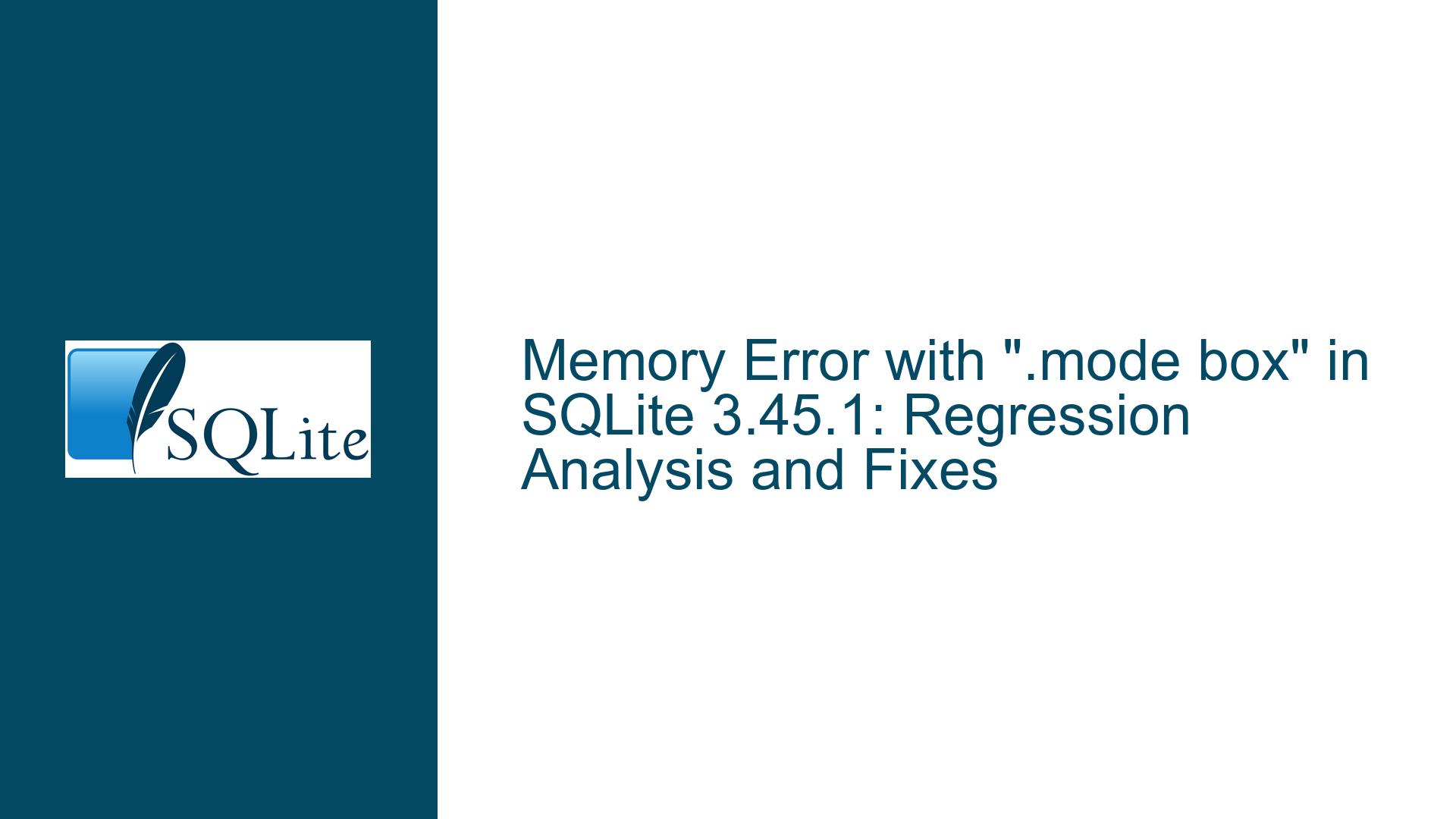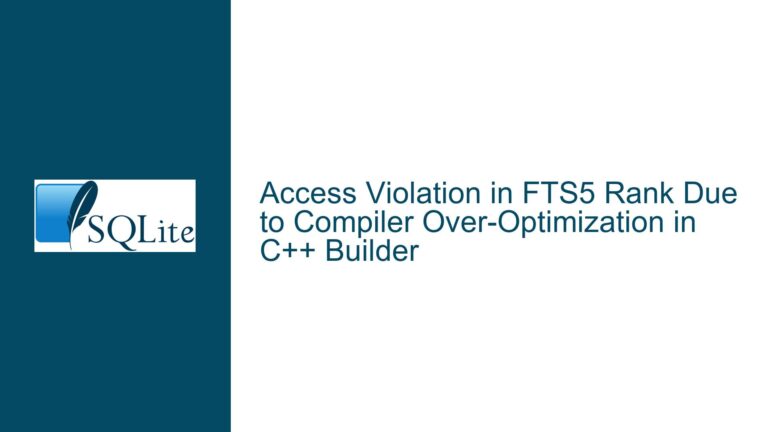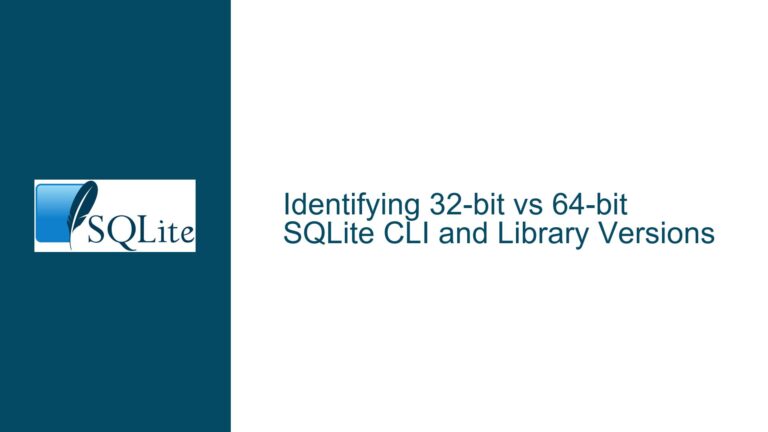Memory Error with “.mode box” in SQLite 3.45.1: Regression Analysis and Fixes
Issue Overview: Memory Allocation Failure During Incremental Vacuum with Box Output Mode
The core issue revolves around an "out of memory" error occurring in SQLite version 3.45.1 when executing the pragma incremental_vacuum(1) command after setting the output mode to "box" using .mode box. This error is a regression, meaning it was previously resolved but has reappeared in this version. The error does not manifest when the .mode box command is omitted, indicating a direct correlation between the output mode setting and the memory allocation failure during the incremental vacuum operation.
The scenario involves creating a table foo with two columns, a (integer) and b (blob). Two rows are inserted into the table, each containing a zeroblob of 4000 bytes. One row is then deleted, and an incremental vacuum operation is attempted. The incremental vacuum is designed to reclaim space from the database file by removing pages that are no longer in use. However, the operation fails with an "out of memory" error when the output mode is set to "box".
The error is particularly concerning because it suggests a regression in SQLite’s memory management or output handling mechanisms. The fact that the error is tied to the .mode box command implies that the issue may be related to how SQLite handles memory allocation or deallocation when formatting output in box mode. This regression could have broader implications for users who rely on the incremental vacuum feature to maintain database performance and storage efficiency.
Possible Causes: Memory Management and Output Mode Interaction
The "out of memory" error in this context can be attributed to several potential causes, all of which are related to the interaction between SQLite’s memory management system and the output mode settings. One of the primary suspects is the way SQLite allocates and deallocates memory when formatting query results in box mode. The box output mode is designed to present query results in a visually appealing, tabular format, which may require additional memory for formatting and buffering.
When the .mode box command is executed, SQLite may allocate memory for internal buffers or structures that are used to format the output. If this memory allocation is not properly managed, it could lead to a situation where subsequent operations, such as the incremental vacuum, fail due to insufficient available memory. This is particularly problematic in environments with limited memory resources, where even small memory leaks or inefficiencies can lead to out-of-memory errors.
Another possible cause is a regression in the memory management code that was previously fixed but has resurfaced in SQLite 3.45.1. The earlier fix, which addressed a similar issue, may have been inadvertently reverted or modified in a way that reintroduced the problem. This could happen if changes to the codebase were not thoroughly tested for interactions with the output mode settings, leading to a situation where the memory management system behaves differently when the output mode is set to "box".
Additionally, the error could be related to how SQLite handles large objects, such as the zeroblob used in the example. The zeroblob function creates a BLOB (Binary Large Object) of a specified size, which in this case is 4000 bytes. When these large objects are deleted, SQLite may need to perform additional memory management tasks to reclaim the space they occupied. If the output mode is set to "box", these tasks may be more memory-intensive, leading to the observed out-of-memory error.
Troubleshooting Steps, Solutions & Fixes: Addressing the Memory Error in SQLite 3.45.1
To address the "out of memory" error in SQLite 3.45.1, several troubleshooting steps and solutions can be employed. The first step is to verify that the issue is indeed a regression by testing the same sequence of commands in earlier versions of SQLite. If the error does not occur in previous versions, this confirms that the issue is specific to SQLite 3.45.1 and is likely a regression.
Once the regression is confirmed, the next step is to apply the fix that has been implemented in the SQLite trunk. The fix involves a slight alteration to the prior solution that addressed a similar issue. By updating to a version of SQLite that includes this fix, users can resolve the out-of-memory error and restore the functionality of the incremental vacuum operation when the output mode is set to "box".
For users who are unable to update to a newer version of SQLite immediately, a temporary workaround is to avoid using the .mode box command when performing incremental vacuum operations. Instead, users can switch to a different output mode, such as "list" or "column", which may not trigger the memory allocation issue. This workaround allows users to continue using the incremental vacuum feature without encountering the out-of-memory error, albeit with a less visually appealing output format.
In addition to applying the fix or using a workaround, users should also consider optimizing their database operations to reduce memory usage. This can be achieved by minimizing the use of large objects, such as zeroblob, and by performing regular maintenance tasks, such as vacuuming, to keep the database file size in check. By reducing the memory footprint of database operations, users can mitigate the risk of encountering out-of-memory errors, even in environments with limited memory resources.
Finally, users should monitor the SQLite mailing lists and forums for updates on this issue and any related fixes. The SQLite development team is highly responsive to user feedback and regularly releases updates to address bugs and regressions. By staying informed about the latest developments, users can ensure that they are using the most stable and reliable version of SQLite available.
In conclusion, the "out of memory" error in SQLite 3.45.1 when using the .mode box command is a regression that has been addressed in the SQLite trunk. Users can resolve the issue by updating to a version of SQLite that includes the fix or by using a temporary workaround to avoid the problematic output mode. Additionally, optimizing database operations and staying informed about updates can help users maintain a stable and efficient database environment.






